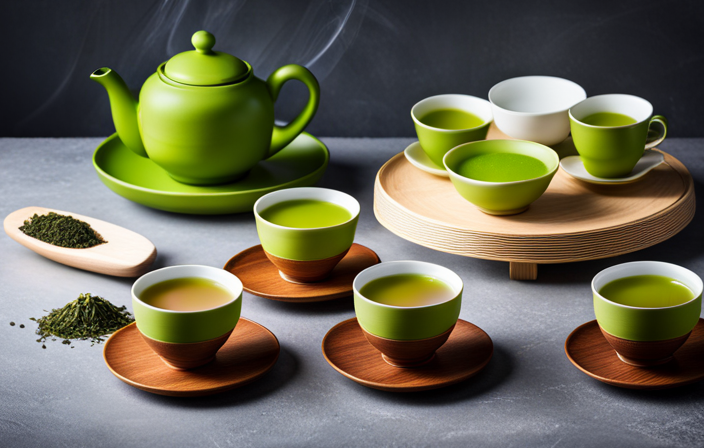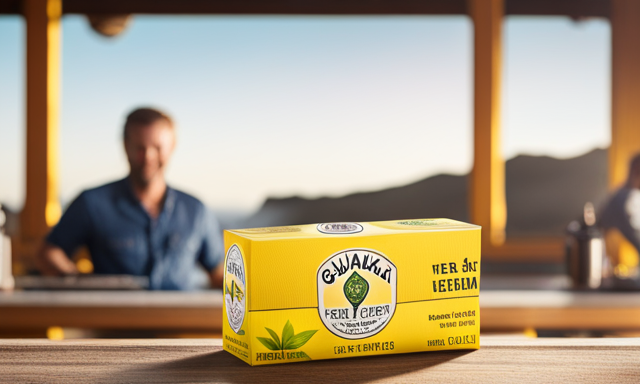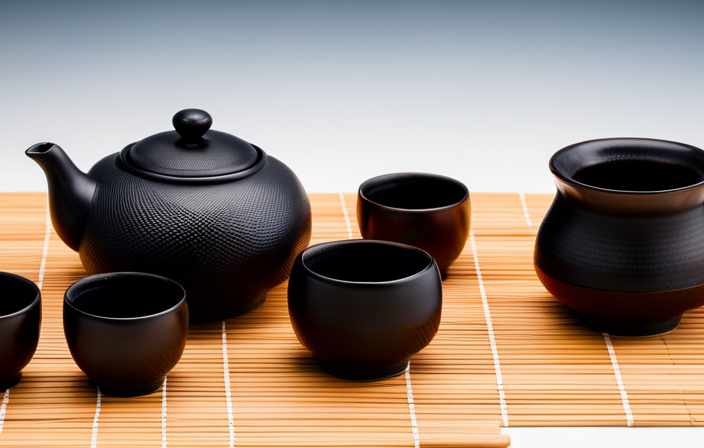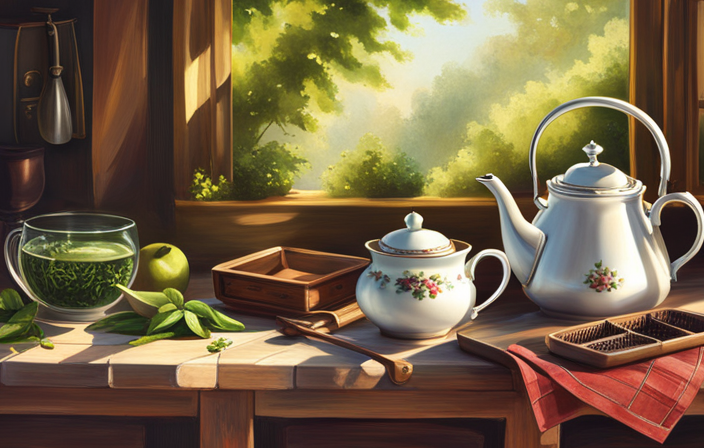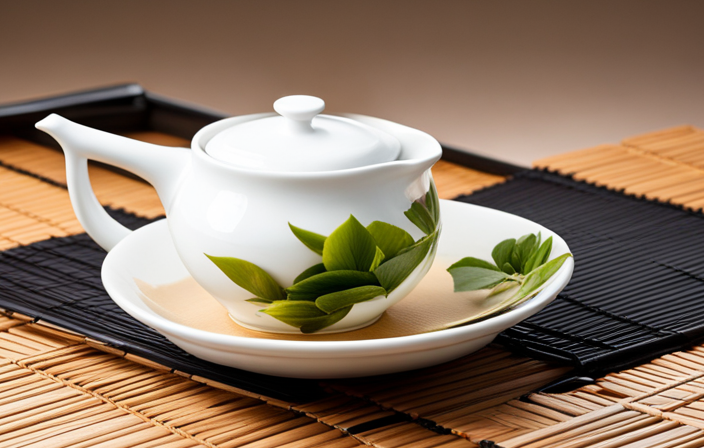Hello! Prepare yourself to explore the fantastic world of green tea.
In this article, I’ll be unraveling the mysteries behind the ten most fascinating types of green tea.
From the refreshing Sencha to the fragrant Jasmine, and the vibrant Matcha to the toasty Houjicha, prepare to be amazed by the variety and richness of green tea flavors.
So grab a cup, sit back, and let’s embark on this delightful journey together!
Key Takeaways
- Green tea is rich in antioxidants, which help protect against free radicals and reduce the risk of chronic diseases.
- Different types of green tea have unique flavors and aromas, such as sencha with its grassy flavor and dragonwell with its nutty flavor.
- Green tea can aid in weight loss and boost metabolism, with certain types like matcha being particularly effective.
- Brewing techniques and equipment vary for different types of green tea, with recommended temperatures and steeping times to achieve the best flavor.
Sencha Green Tea
I love how the grassy flavor of sencha green tea refreshes my palate. Not only does it taste delicious, but it also offers numerous health benefits.
Sencha green tea is rich in antioxidants, which help protect the body against free radicals and reduce the risk of chronic diseases. It also contains catechins, a type of antioxidant that can boost metabolism and aid in weight loss.
When it comes to brewing techniques, it’s important to use water that’s around 175°F to avoid a bitter taste. Steep the tea for around 1-2 minutes to achieve a delicate and flavorful cup.
Sencha green tea isn’t only a treat for the taste buds but also a wonderful addition to a healthy lifestyle.
Dragonwell Green Tea
There are so many different types of green tea, but my favorite is Dragonwell Green Tea because it has a unique nutty flavor that I find incredibly satisfying.
Dragonwell, also known as Longjing, is a famous Chinese green tea that originates from the Hangzhou region. The tea leaves are handpicked and carefully processed to maintain their delicate taste and aroma.
What sets Dragonwell apart isn’t just its exquisite taste, but also its numerous health benefits. Packed with antioxidants, it helps boost the immune system and promotes overall well-being. It’s also known to support weight loss, improve digestion, and reduce the risk of heart disease.
Drinking Dragonwell Green Tea isn’t only a delightful experience but also a way to take care of your health. So, why not indulge in a cup of this marvelous tea and reap its many benefits?
Gunpowder Green Tea
Two teaspoons of Gunpowder Green Tea and a dash of honey make for a refreshing and invigorating drink. Gunpowder Green Tea, known for its unique rolled leaves resembling gunpowder pellets, is a type of green tea that has been enjoyed for centuries. Its distinctive taste and numerous health benefits make it a popular choice among tea enthusiasts.
Gunpowder Green Tea is known for its strong, smoky flavor with a hint of sweetness. This bold taste is a result of its unique production process, which involves withering and steaming the leaves before rolling them into tight pellets. When steeped, these pellets unfurl, releasing their full flavor and aroma.
Not only does Gunpowder Green Tea tantalize the taste buds, but it also offers a range of health benefits. Rich in antioxidants, it helps to boost the immune system and fight off harmful free radicals. It also aids digestion, promotes weight loss, and improves heart health.
Jasmine Green Tea
I love the fragrant aroma of jasmine green tea as it fills the room. The delicate scent instantly transports me to a serene garden, calming my mind and soothing my soul.
But the benefits of jasmine green tea extend far beyond its delightful aroma. This exquisite tea isn’t only a treat for the senses but also a powerhouse of health benefits.
Known for its antioxidant properties, jasmine green tea helps to protect the body against free radicals, reducing the risk of chronic diseases. It also aids in digestion, boosts metabolism, and promotes weight loss.
Additionally, jasmine green tea is believed to enhance mental clarity and reduce stress, making it the perfect companion for those seeking a moment of tranquility in their busy lives.
Matcha Green Tea
Matcha green tea isn’t just your average cup of tea; it’s a vibrant, powdered beverage that offers a multitude of health benefits.
From boosting metabolism to providing a calm, focused energy, matcha is a powerhouse of antioxidants and nutrients.
To fully enjoy its unique flavor and benefits, it’s important to learn the best brewing techniques and understand how to properly incorporate matcha into your daily routine.
Health Benefits Explained
Although it’s commonly known that green tea has numerous health benefits, understanding the specific advantages of matcha green tea can be quite enlightening. Matcha green tea is a powdered form of green tea that has gained popularity for its unique flavor and potential health benefits.
Here are some key health benefits of matcha green tea:
-
High in antioxidants: Matcha contains a high concentration of antioxidants, which help protect the body against oxidative stress and reduce the risk of chronic diseases.
-
Boosts metabolism: Matcha has been shown to increase metabolism and promote fat burning, making it a great addition to a weight loss or maintenance plan.
When it comes to brewing methods, matcha is traditionally prepared by whisking the powdered tea with hot water. This method ensures that you consume the entire tea leaf, maximizing its health benefits.
Additionally, matcha can be used in various recipes, such as smoothies, lattes, and desserts, allowing you to enjoy its health benefits in different ways.
Best Brewing Techniques
One of the best brewing techniques for matcha green tea is to whisk it with hot water, ensuring a smooth and flavorful cup. Matcha, a powdered green tea, offers numerous health benefits due to its high concentration of antioxidants. This vibrant and invigorating tea is known for boosting metabolism, enhancing focus, and promoting relaxation.
It’s important to note that different green tea varieties require different brewing techniques to achieve their optimal flavor and benefits. For example, sencha, a popular Japanese green tea, is best brewed with water that’s around 160°F to preserve its delicate flavors. On the other hand, bancha, a milder Japanese green tea, can be brewed with slightly hotter water at 175°F. Understanding the unique characteristics of each green tea variety allows us to savor their distinct flavors and reap their health benefits.
Now, let’s dive into the world of genmaicha green tea.
Genmaicha Green Tea
I often enjoy sipping on a warm cup of Genmaicha Green Tea, relishing its unique blend of rice and green tea flavors. This delightful Japanese tea has gained popularity not only for its taste but also for its numerous health benefits.
Here are some brewing techniques and health benefits of Genmaicha Green Tea that will enhance your tea-drinking experience:
-
Brewing Techniques:
-
Use water at a temperature of around 175°F to 185°F for the perfect balance of flavors.
-
Steep the tea for 2-3 minutes to extract the full range of flavors.
-
Health Benefits:
-
Rich in antioxidants, Genmaicha Green Tea helps in boosting the immune system and fighting free radicals.
-
It aids in digestion and promotes a healthy gut due to the presence of polyphenols and catechins.
Houjicha Green Tea
Houjicha green tea is a delightful roasted variation that offers a unique flavor profile. With its toasty notes and nutty undertones, it stands out among other green teas.
What makes houjicha even more appealing is its low caffeine content, making it a great choice for those looking for a milder tea experience.
Roasted Flavor Profile
There’s something about the unique roasted flavor of houjicha green tea that I can’t get enough of. It’s a taste that instantly transports me to a cozy teahouse, where I can relax and savor every sip.
The roasting technique used in houjicha is what gives it that distinct flavor. Here are some benefits and roasting techniques that make houjicha so special:
-
Benefits of the roasted flavor:
-
A warming and comforting sensation
-
Reduced caffeine content, making it suitable for evening enjoyment
-
Roasting techniques:
-
Houjicha is made from roasted Bancha leaves, which are grown in direct sunlight.
-
The leaves are harvested in the summer and then roasted to perfection, resulting in a toasty, nutty flavor.
The roasting process not only enhances the taste but also brings out unique aromas and rich colors.
Low Caffeine Content
Although houjicha is known for its rich roasted flavor, it has a surprisingly low caffeine content compared to other types of green tea. This makes it an excellent choice for those who are sensitive to caffeine or prefer a more calming and relaxing tea experience.
The benefits of low caffeine content in green tea are numerous. It can help improve sleep quality, reduce anxiety, and promote a sense of well-being. The best time to consume low caffeine green tea is in the evening or before bedtime, as it won’t interfere with sleep patterns. It can also be enjoyed during the day as a soothing and refreshing beverage.
Unique Brewing Techniques
I love exploring the unique brewing techniques for green tea, as each method brings out different flavors and aromas that make the experience truly one-of-a-kind. When it comes to brewing green tea, having the right equipment is essential. Here are two essential brewing equipment that can enhance your tea experience:
-
Teapot: A teapot allows the leaves to expand fully and release their flavors. Opt for a ceramic or glass teapot to preserve the delicate flavors of green tea.
-
Tea Infuser: A tea infuser is a convenient tool for steeping loose tea leaves. It ensures that the leaves are properly infused while preventing any debris from entering your cup.
To make the most out of your green tea, it’s crucial to pay attention to steeping times. Different green teas have varying steeping times, usually ranging from 1 to 3 minutes. It’s best to experiment and find the perfect steeping time that suits your taste preferences.
Now, let’s delve into the fascinating world of gyokuro green tea.
Gyokuro Green Tea
I love the rich, umami flavor of gyokuro green tea.
Gyokuro is a type of Japanese green tea that’s highly revered for its unique cultivation process and exquisite flavor profile. The cultivation process begins with shading the tea bushes for several weeks before harvest.
This shading technique enhances the production of chlorophyll and amino acids, resulting in a distinct umami taste. The leaves are then hand-picked and carefully processed to preserve their delicate flavors.
The flavor profile of gyokuro is characterized by its deep green color, vegetal notes, and a smooth, buttery texture. It has a subtle sweetness and a lingering aftertaste that’s both refreshing and satisfying.
Whether enjoyed hot or cold, gyokuro green tea is a true delight for tea enthusiasts seeking a refined and indulgent experience.
Longjing Green Tea
Longjing Green Tea is known for its delicate, chestnut-like flavor that leaves a refreshing sensation on the palate. Originating from the West Lake region of Hangzhou, China, this tea has a rich history dating back to the Tang Dynasty. It’s said that the tea’s name, Longjing, translates to ‘Dragon Well’ due to the shape of the leaves resembling the curved back of a dragon.
To fully appreciate Longjing Green Tea, here are some tips to enhance your experience:
- Choosing the right tea: Look for tea leaves that are flat, straight, and have a vibrant green color.
- Brewing technique: Use water that’s around 175°F and steep the leaves for 2-3 minutes for the first infusion.
- Health benefits: Longjing Green Tea is known for its high levels of antioxidants and can aid in digestion, boost the immune system, and improve mental alertness.
By understanding the history and origins, along with mastering the brewing techniques, you can fully enjoy the exquisite flavors and health benefits that Longjing Green Tea has to offer.
Bancha Green Tea
The Bancha Green Tea is a traditional Japanese tea known for its mild and grassy flavor. It holds a special place in the hearts of tea enthusiasts, as it has been an integral part of the traditional Japanese tea ceremony for centuries.
This tea is made from the larger and more mature leaves of the tea plant, giving it a unique flavor profile. The leaves are harvested in late summer or early autumn, resulting in a tea that’s lower in caffeine and higher in catechins.
Bancha Green Tea is often enjoyed for its refreshing and soothing qualities, making it a popular choice for those seeking a moment of tranquility. Whether served hot or cold, this tea offers a delightful experience that truly embodies the essence of the traditional Japanese tea ceremony.
Frequently Asked Questions
Is It Possible to Mix Different Types of Green Tea Together to Create a Unique Blend?
Yes, it is possible to mix different types of green tea together to create a unique blend. By blending green teas, you can unlock a world of flavors and benefits, allowing you to experiment and create your own perfect cup.
How Can I Store My Green Tea to Ensure It Stays Fresh for a Long Time?
To ensure long term freshness, store your green tea in an airtight container away from light, moisture, and strong odors. Avoid mixing different types of green tea together, as it may affect the taste and quality of the blend.
Are There Any Health Benefits Specific to Each Type of Green Tea?
There are indeed specific health benefits associated with each type of green tea. It is important to choose the right type of green tea based on the specific health benefits you are seeking.
Can Green Tea Be Enjoyed Cold or Is It Best Served Hot?
I personally believe that green tea can be enjoyed both hot and cold. Each way offers a unique experience, and it ultimately comes down to personal preference. Exploring different flavor combinations for cold brewing can be a delightful journey.
Are There Any Specific Brewing Techniques or Utensils That Are Recommended for Each Type of Green Tea?
When it comes to brewing green tea, each type requires specific techniques and utensils. From delicate sencha to robust matcha, understanding the proper way to brew and serve each tea ensures a truly enjoyable experience.
Conclusion
After exploring the world of green tea, it’s clear that its diversity is truly remarkable.
Did you know that consuming just one cup of green tea a day can lower the risk of developing heart disease by 10%? This statistic highlights the incredible health benefits of this ancient beverage and can inspire us to incorporate green tea into our daily routine.
So, let’s raise a cup and toast to the wonders of green tea and its endless possibilities!

